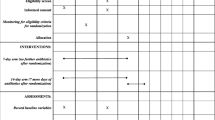Abstract
Objective
To compare a short course of antibiotics (48 to 96 hours) and a standard course of antibiotics (7 days) for probable neonatal sepsis.
Design
Randomized, controlled, open-labeled trial with blocking and stratification according to birth weight.
Setting
Tertiary care, referral, teaching hospital in Northern India.
Participants
Neonates >30 wks gestation and >1000 g at birth, with probable sepsis (clinical signs of sepsis, raised C-reactive protein) were enrolled. Babies with major malformations, severe birth asphyxia, meningitis, bone or joint or deep-seated infection, those who were already on antibiotics, and those undergoing surgery were excluded. Neonates, who had clinically remitted on antibiotic therapy — by the time a sterile blood culture report was received — were randomized.
Intervention
In the intervention arm, antibiotics were stopped after the 48-hour culture was reported sterile. In the control arm, antibiotics were continued to a total of 7 days.
Main outcome measure
“Treatment failure” defined as reappearance of signs suggestive of sepsis within 15 days of stopping antibiotics, supported by laboratory evidence and adjudicated by a blinded expert committee.
Results
52 neonates were randomized to receive a short course or 7-day course (n=26 each). Baseline variables were balanced in the 2 groups. There was no significant difference in the treatment failures between the 2 groups (3 babies in the 7-day group vs none in short course group, P=0.23).
Conclusion
No difference in the treatment failure rates could be identified between short course and 7-day groups among neonates >30 weeks and >1000 grams with probable sepsis.
Similar content being viewed by others
References
Schelonka RL, Freij BJ, McCrecken GH Jr. Bacterial and fungal infections. In: MacDonald MG, Seshia MMK, Mullett MD, editors. Avery’s Neonatology. Pathophysiology and management of the newborn. 6th ed. Philadelphia: Lippincott William Wilkins. 1999. p. 1235–1275.
Klein JO. Bacterial sepsis and meningitis. In: Remington JS, Klein JO, editors. Infectious Diseases of Fetus and Newborn Infant. 5th Ed. Philadelphia: WB Saunders & Co. 2001.p.943–999.
Dear P. Neonatal infections: Infections in the newborn. In: Rinnie JM editor. Roberton’s Textbook of Neonatology. 4th ed. Elsevier Churchill Livingstone; 2005. p. 1011–1093.
Hammerschlag MR, Klein JO, Herschel M, Chen FC, Fermin R. Patterns of use of antibiotics in two newborn nurseries. N Engl J Med. 1977;296:1268–1269.
Philip AG, Hewitt JR. Early diagnosis of neonatal sepsis. Pediatrics. 1980;65:1036–1041.
Goldmann DA, Leclair J, Macone A. Bacterial colonization of neonates admitted to an intensive care environment. J Pediatr. 1978;93:288–293.
Lacey RW. Evolution of microorganisms and antibiotic resistance. Lancet. 1984;2:1022–1025.
Low DE, Scheld WM. Strategies for stemming the tide of antimicrobial resistance. JAMA. 1998;279:394–395.
Gray JE, Ringer SA. Common neonatal procedures. Cloherty JP, Eichenwald EC, Stark AR editors. In: Manual of Neonatal Care. 5th ed. Philadelphia: Lippincott William Wilkins. 2004.p.687–702.
Ehl S, Gering B, Bartmann P, Hagel J, Pohlandt F. Creactive protein is a useful marker for guiding duration of antibiotic therapy in suspected neonatal bacterial infection. Pediatrics. 1997;99:216–221.
Bomela HN, Ballot DE, Cory BJ, Cooper PA. Use of Creactive protein to guide duration of empiric antibiotic therapy in suspected early neonatal sepsis. Pediatr Infect Dis J. 2000;19:531–535.
Khashabi J, Karamiyar M, Taghinejhad H, Shirazi M. Use of serial C-reactive protein measurements for determination of the length of empiric antibiotic therapy in suspected neonatal sepsis. Iran J Med Sci. 2004;29: 31–35.
Lee WE, Chan ML, Young BWY. Reducing hospitalization and antibiotic use in suspected early neonatal sepsis through serial measurements of C-reactive proteins. HK J Pediatr. 2005;10:3–9.
Engle WD, Jackson GL, Sendalbach D, Ford D, Oleson B, Burton KM, et al. Neonatal pneumonia: comparison of 4 Vs 7 days antibiotic therapy in term and near-term infants. J Perinatol. 2000;20:421–426.
Author information
Authors and Affiliations
Corresponding author
Rights and permissions
About this article
Cite this article
Saini, S.S., Dutta, S., Ray, P. et al. Short course versus 7-day course of intravenous antibiotics for probable neonatal septicemia: A pilot, open-label, randomized controlled trial . Indian Pediatr 48, 19–24 (2011). https://doi.org/10.1007/s13312-011-0019-8
Received:
Published:
Issue Date:
DOI: https://doi.org/10.1007/s13312-011-0019-8




